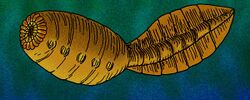Biology:Pomatrum
| Pomatrum | |
|---|---|

| |
| Artist's conception | |
| Scientific classification | |
| Domain: | Eukaryota |
| Kingdom: | Animalia |
| Phylum: | †Vetulicolia |
| Class: | †Vetulicolida |
| Order: | †Vetulicolata |
| Family: | †Didazoonidae |
| Genus: | †Pomatrum Luo and Hu, in Luo et al., 1999 |
| Species: | †P. ventralis
|
| Binomial name | |
| †Pomatrum ventralis Luo and Hu, in Luo et al., 1999
| |
| Synonyms | |
|
Xidazoon stephanus[1] | |
Pomatrum is an extinct vetulicolian, the senior synonym of Xidazoon; the latter taxon was described by Shu, et al. (1999) based on fossils found in the Qiongzhusi (Chiungchussu) Formation, Yu'anshan Member (Eoredlichia zone), Lower Cambrian, Haikou, (Kunming), about 50 km west of Chengjiang, China . It has been likened to the chordate Pipiscius.[2]
The fossils show that the body of the animal was divided into two parts. The anterior part of the body is moderately inflated, with a prominent mouth circlet. It has faint transverse divisions towards the front, but is otherwise smooth. The mouth circlet consists of about 30 plates divided into inner and outer regions. The anterior section has five structures on each side, which are interpreted as gills. A dark region running close to the ventral and posterior margins is interpreted as an endostyle. The condition of the anterior portion of the fossils suggests that it was thin-walled, i.e., that the anterior portion was largely hollow. The posterior part of the body tapers towards front and back (diamond-shaped), and is divided into seven segments covered in cuticle with three less well-defined segments at the anterior end.[3] There are short spines at the posterior tip. The authors describe an alimentary canal with terminal openings and a rectum with what might be dilator muscles.
Based on a comparison of the incomplete/damaged holotype with the incomplete/damaged holotype of Pomatrum ventralis, researchers Aldridge, et al., proposed that X. stephanus was a junior synonym of P. ventralis because the anterior portions of the two species are largely identical.[1]
See also
- Maotianshan shales
References
- ↑ 1.0 1.1 Aldridge, Richard J.; Xian-Guang, HOU; Siveter, David J.; Siveter, Derek J.; Gabbott, Sarah E. (2007). "The Systematics and Phylogenetic Relationships of Vetulicolians". Palaeontology 50: 131–168. doi:10.1111/j.1475-4983.2006.00606.x.
- ↑ Shu, D.; Morris, S. Conway; Zhang, X-L.; Chen, L.; Li, Y.; Han, J. (1999). "A pipiscid-like fossil from the Lower Cambrian of south China". Nature 400 (6746): 746. doi:10.1038/23445. Bibcode: 1999Natur.400..746S.
- ↑ Shu, Degan (2005). "On the Phylum Vetulicolia". Chinese Science Bulletin 50 (20): 2342–2354. doi:10.1007/BF03183746. Bibcode: 2005ChSBu..50.2342S.
- Shu, D.-G.; Morris, S. Conway; Han, J.; Chen, L.; Zhang, X.-L.; Zhang, Z.-F.; Liu, H.-Q.; Li, Y. et al. (2001). "Primitive deuterostomes from the Chengjiang Lagerstätte (Lower Cambrian, China)". Nature 414 (6862): 419–424. doi:10.1038/35106514. PMID 11719797. Bibcode: 2001Natur.414..419S.
Wikidata ☰ Q1588028 entry
 |

